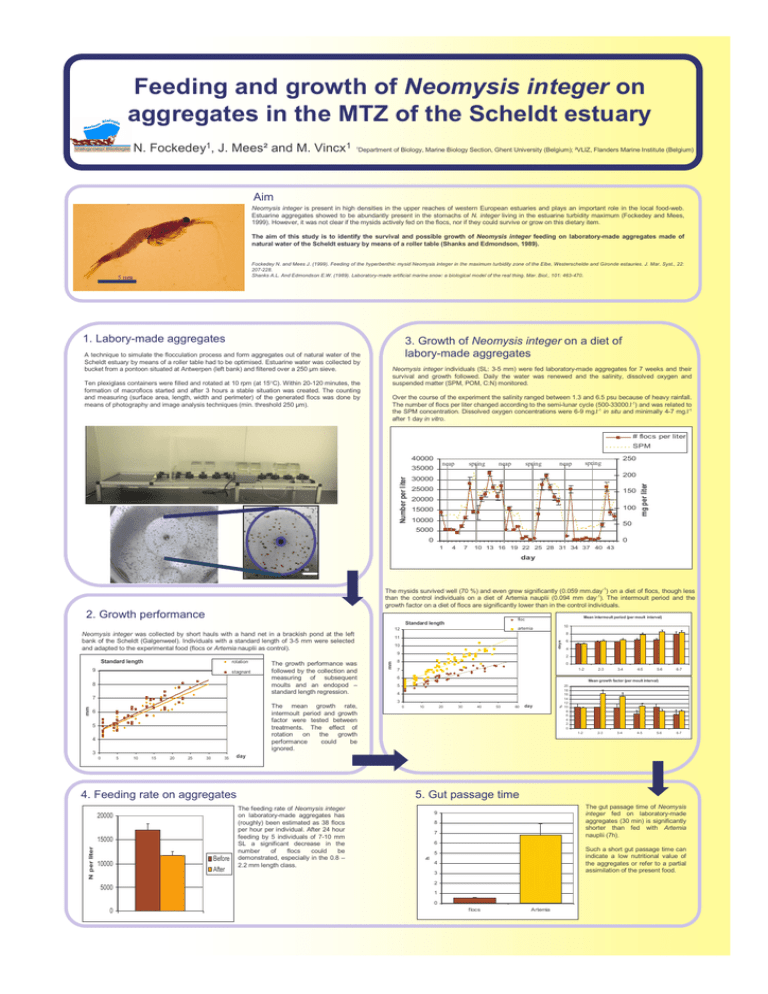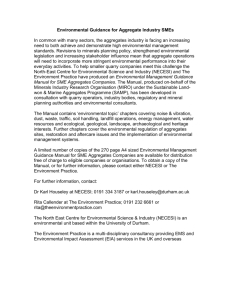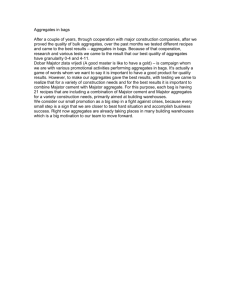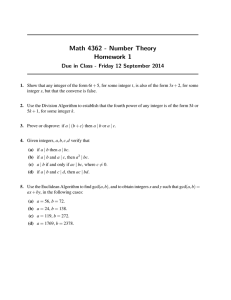Aim
advertisement

Feeding and growth of Neomysis integer on aggregates in the MTZ of the Scheldt estuary N. Fockedey1, J. Mees² and M. Vincx1 1 Department of Biology, Marine Biology Section, Ghent University (Belgium); ²VLIZ, Flanders Marine Institute (Belgium) Aim Neomysis integer is present in high densities in the upper reaches of western European estuaries and plays an important role in the local food-web. Estuarine aggregates showed to be abundantly present in the stomachs of N. integer living in the estuarine turbidity maximum (Fockedey and Mees, 1999). However, it was not clear if the mysids actively fed on the flocs, nor if they could survive or grow on this dietary item. The aim of this study is to identify the survival and possible growth of Neomysis integer feeding on laboratory-made aggregates made of natural water of the Scheldt estuary by means of a roller table (Shanks and Edmondson, 1989). Fockedey N. and Mees J. (1999). Feeding of the hyperbenthic mysid Neomysis integer in the maximum turbidity zone of the Elbe, Westerschelde and Gironde estauries. J. Mar. Syst., 22: 207-228. Shanks A.L. And Edmondson E.W. (1989). Laboratory-made artificial marine snow: a biological model of the real thing. Mar. Biol., 101: 463-470. 5 mm 1. Labory-made aggregates 3. Growth of Neomysis integer on a diet of labory-made aggregates A technique to simulate the flocculation process and form aggregates out of natural water of the Scheldt estuary by means of a roller table had to be optimised. Estuarine water was collected by bucket from a pontoon situated at Antwerpen (left bank) and filtered over a 250 µm sieve. Neomysis integer individuals (SL: 3-5 mm) were fed laboratory-made aggregates for 7 weeks and their survival and growth followed. Daily the water was renewed and the salinity, dissolved oxygen and suspended matter (SPM, POM, C:N) monitored. Ten plexiglass containers were filled and rotated at 10 rpm (at 15°C). Within 20-120 minutes, the formation of macroflocs started and after 3 hours a stable situation was created. The counting and measuring (surface area, length, width and perimeter) of the generated flocs was done by means of photography and image analysis techniques (min. threshold 250 µm). Over the course of the experiment the salinity ranged between 1.3 and 6.5 psu because of heavy rainfall. The number of flocs per liter changed according to the semi-lunar cycle (500-33000.l-1) and was related to the SPM concentration. Dissolved oxygen concentrations were 6-9 mg.l-1 in situ and minimally 4-7 mg.l-1 after 1 day in vitro. # flocs per liter SPM 40000 neap 35000 neap spring 250 spring neap 200 30000 25000 150 20000 100 15000 10000 mg per liter Number per liter According to Shanks and Edmondson (1989) spring 50 5000 0 0 1 4 7 10 13 16 19 22 25 28 31 34 37 40 43 day 10 mm The mysids survived well (70 %) and even grew significantly (0.059 mm.day-1) on a diet of flocs, though less than the control individuals on a diet of Artemia nauplii (0.094 mm day-1). The intermoult period and the growth factor on a diet of flocs are significantly lower than in the control individuals. 2. Growth performance Mean intermoult period (per moult interval) floc Standard length 10 artemia 12 Neomysis integer was collected by short hauls with a hand net in a brackish pond at the left bank of the Scheldt (Galgenweel). Individuals with a standard length of 3-5 mm were selected and adapted to the experimental food (flocs or Artemia nauplii as control). 8 days 11 10 9 stagnant 8 The growth performance was followed by the collection and measuring of subsequent moults and an endopod – standard length regression. mm 7 The mean growth rate, intermoult period and growth factor were tested between treatments. The effect of rotation on the growth performance could be ignored. 6 5 4 3 0 5 10 15 20 25 30 35 N per liter 15000 10000 5000 Before After 0 7 1-2 6 2-3 3-4 4-5 5-6 6-7 Mean growth factor (per moult interval) 5 4 3 0 10 20 30 40 50 60 day 20 18 16 14 12 10 8 6 4 2 0 1-2 2-3 3-4 4-5 5-6 6-7 5. Gut passage time The feeding rate of Neomysis integer on laboratory-made aggregates has (roughly) been estimated as 38 flocs per hour per individual. After 24 hour feeding by 5 individuals of 7-10 mm SL a significant decrease in the number of flocs could be demonstrated, especially in the 0.8 – 2.2 mm length class. The gut passage time of Neomysis integer fed on laboratory-made aggregates (30 min) is significantly shorter than fed with Artemia nauplii (7h). 9 8 7 6 Such a short gut passage time can indicate a low nutritional value of the aggregates or refer to a partial assimilation of the present food. 5 4 3 2 1 0 0 4 day 4. Feeding rate on aggregates 20000 6 2 8 % rotation h Standard length mm 9 flocs Artemia






